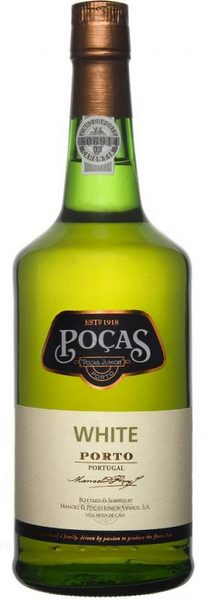 Poças White Port – Conventional
Poças White Port – Conventional
Versatile white Port wine offers a range of flavors, from fresh and young aperitifs to rich and complex wines aged in wood for up to 40 years. An impressive drink on its own, it’s used in cocktails like the porto tónico (white Port and tonic) and can pair easily with food.
White Port, made in small quantities by only about 30 producers, is unique to Portugal’s Douro Valley, a UNESCO World Heritage Site where Port has been made since the 1600s. The fortified wine can range from mostly dry to intensely sweet.
The same blend of native white grapes used to make Douro’s dry white wines are also used to create white Port. However, the style accounts for only 10% of all Port production. These grapes grow on high ground above the Douro River valley, where the summer temperatures are cooler.
The grapes used in white Port are:
Malvasia Fina: A subtle, full-bodied variety that brings notes of molasses and nutmeg
Gouveio: Offers apple aromas, with lively acidity and a smooth feel
Viosinho: A low-yield variety that adds structure and intense aromas
Códega do Larinho: An old Portuguese grape with low acidity and a tendency toward high alcohol
Moscatel Galego Branco: Offers aromatic lift via orange and apricot characteristics that are essential to white Port
Rabigato: Adds refreshing acidity to the blend
Just like red Ports, white Port is fortified with clear brandy to stop fermentation. It’s either put into wood casks for aging or kept in tanks to be bottled young. Young is easy to drink, while wood aging adds drama. They are typically 17–20% alcohol by volume (abv).
When used for cocktails, drier styles mix better. The sweetest white Ports are known as lagrima, or tears, and are best enjoyed on their own or with blue cheese, foie gras, pâtés and sardines. All young white Ports are great with seafood.
Poças Ports are one of the few Port houses still owned by the founding family, and one of the few Portuguese-owned Port houses (most are English). The house was established in 1918, dedicated to making the neutral spirit used in Port making with the goal of selling to the large Port houses. Soon after, they starting making fortified wines on their own, and now are celebrating making wines in their 2nd century of existence.
Their white port is lovely, a blend of Malvasia Fina, Códega, Rabigato, and Viosinho, aged in wood for three years, a combination of several different harvests. It’s bright, fruity, and great for an aperitif, or a Porto Tonico (basically a Gin and Tonic, swapping the Gin for White Port).
89 points, Wine Enthusiast: Well integrated, delicate wine. The fruit is fresh, with yellow fruits, mangos, and bitter oranges, which work well with the acidity. The balance is excellent.

